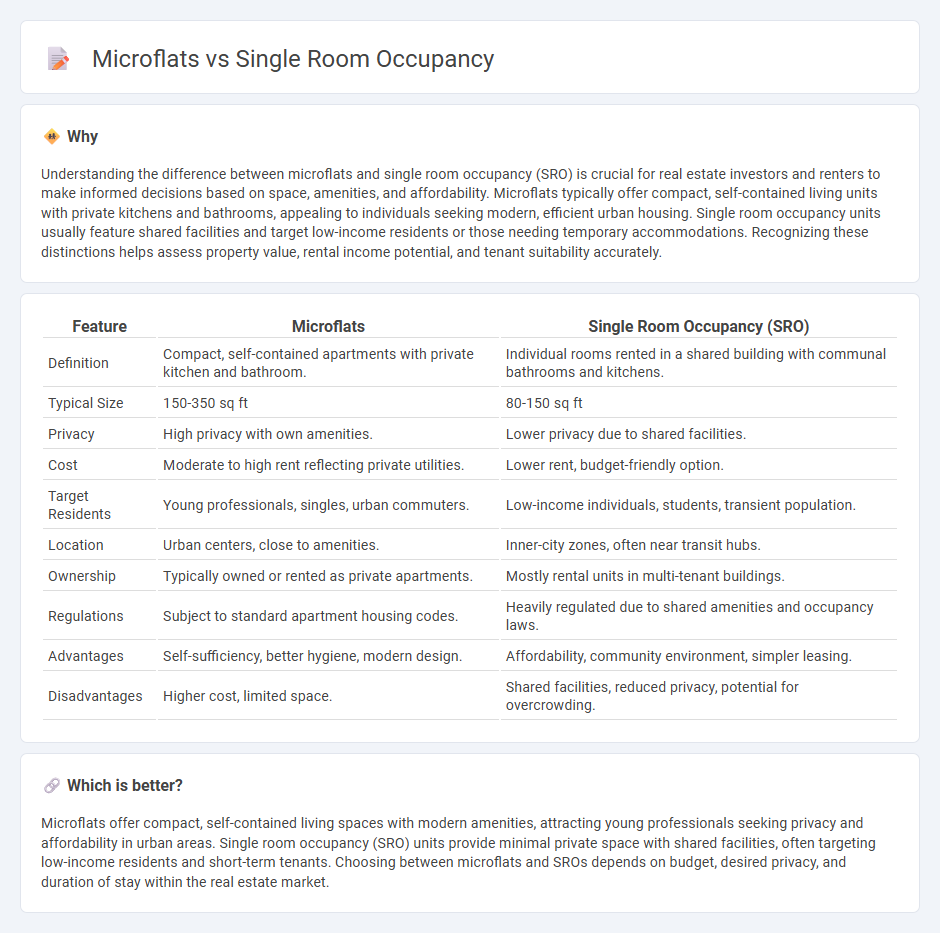
Microflats and single room occupancy (SRO) units offer compact living solutions tailored to urban residents seeking affordability and convenience. Microflats typically provide a self-contained space with a private kitchenette and bathroom, while SROs often feature shared facilities to maximize occupancy and lower costs. Explore detailed comparisons to determine which housing option best suits your lifestyle and investment goals.
Why it is important
Understanding the difference between microflats and single room occupancy (SRO) is crucial for real estate investors and renters to make informed decisions based on space, amenities, and affordability. Microflats typically offer compact, self-contained living units with private kitchens and bathrooms, appealing to individuals seeking modern, efficient urban housing. Single room occupancy units usually feature shared facilities and target low-income residents or those needing temporary accommodations. Recognizing these distinctions helps assess property value, rental income potential, and tenant suitability accurately.
Comparison Table
| Feature | Microflats | Single Room Occupancy (SRO) |
|---|---|---|
| Definition | Compact, self-contained apartments with private kitchen and bathroom. | Individual rooms rented in a shared building with communal bathrooms and kitchens. |
| Typical Size | 150-350 sq ft | 80-150 sq ft |
| Privacy | High privacy with own amenities. | Lower privacy due to shared facilities. |
| Cost | Moderate to high rent reflecting private utilities. | Lower rent, budget-friendly option. |
| Target Residents | Young professionals, singles, urban commuters. | Low-income individuals, students, transient population. |
| Location | Urban centers, close to amenities. | Inner-city zones, often near transit hubs. |
| Ownership | Typically owned or rented as private apartments. | Mostly rental units in multi-tenant buildings. |
| Regulations | Subject to standard apartment housing codes. | Heavily regulated due to shared amenities and occupancy laws. |
| Advantages | Self-sufficiency, better hygiene, modern design. | Affordability, community environment, simpler leasing. |
| Disadvantages | Higher cost, limited space. | Shared facilities, reduced privacy, potential for overcrowding. |
Which is better?
Microflats offer compact, self-contained living spaces with modern amenities, attracting young professionals seeking privacy and affordability in urban areas. Single room occupancy (SRO) units provide minimal private space with shared facilities, often targeting low-income residents and short-term tenants. Choosing between microflats and SROs depends on budget, desired privacy, and duration of stay within the real estate market.
Connection
Microflats and single room occupancy (SRO) units both represent compact living spaces designed to maximize affordability and urban density in high-demand real estate markets. These housing types optimize limited square footage by integrating essential amenities into small, efficient layouts, thereby addressing the growing demand for affordable, flexible living options in metropolitan areas. Property developers and city planners increasingly incorporate microflats and SROs into housing strategies to alleviate urban housing shortages and promote sustainable community development.
Key Terms
Occupancy Density
Single room occupancy (SRO) units typically offer larger individual living spaces designed to house one occupant with shared facilities, resulting in lower occupancy density compared to microflats. Microflats maximize occupancy density by providing compact, self-contained units that efficiently utilize limited urban space, appealing to residents seeking affordability and privacy within minimal square footage. Explore detailed comparisons on occupancy density impacts and urban housing solutions to better understand these housing models.
Shared Amenities
Single room occupancy units typically offer shared amenities such as communal kitchens, bathrooms, and lounge areas, fostering social interaction and cost-efficient living. Microflats, on the other hand, provide private, compact living spaces with limited or no shared facilities, emphasizing independence and personal privacy. Explore the benefits and trade-offs between SROs and microflats to determine which housing option suits your lifestyle needs best.
Unit Size
Single room occupancy (SRO) units typically range between 150 to 300 square feet, offering minimal living space designed primarily for sleeping and basic amenities. Microflats generally provide larger areas, often between 300 to 500 square feet, with more comprehensive kitchen and living facilities, enhancing comfort and functionality. Explore detailed comparisons of unit sizes and design features to determine the best housing solution.
Source and External Links
Single-room occupancy - Single-room occupancy (SRO) is a type of low-cost housing aimed at residents with low or minimal incomes, where residents rent small, furnished single rooms and share common facilities.
Understanding SRO - The HUD guide explains the Single Room Occupancy program, which provides rental assistance to homeless individuals by rehabilitating properties into affordable housing units.
Single-Room Occupancy (SRO) Units in San Diego - San Diego's regulations aim to preserve existing SRO hotel rooms and assist tenants displaced by demolition, conversion, or rehabilitation, protecting low-income residents.
 dowidth.com
dowidth.com